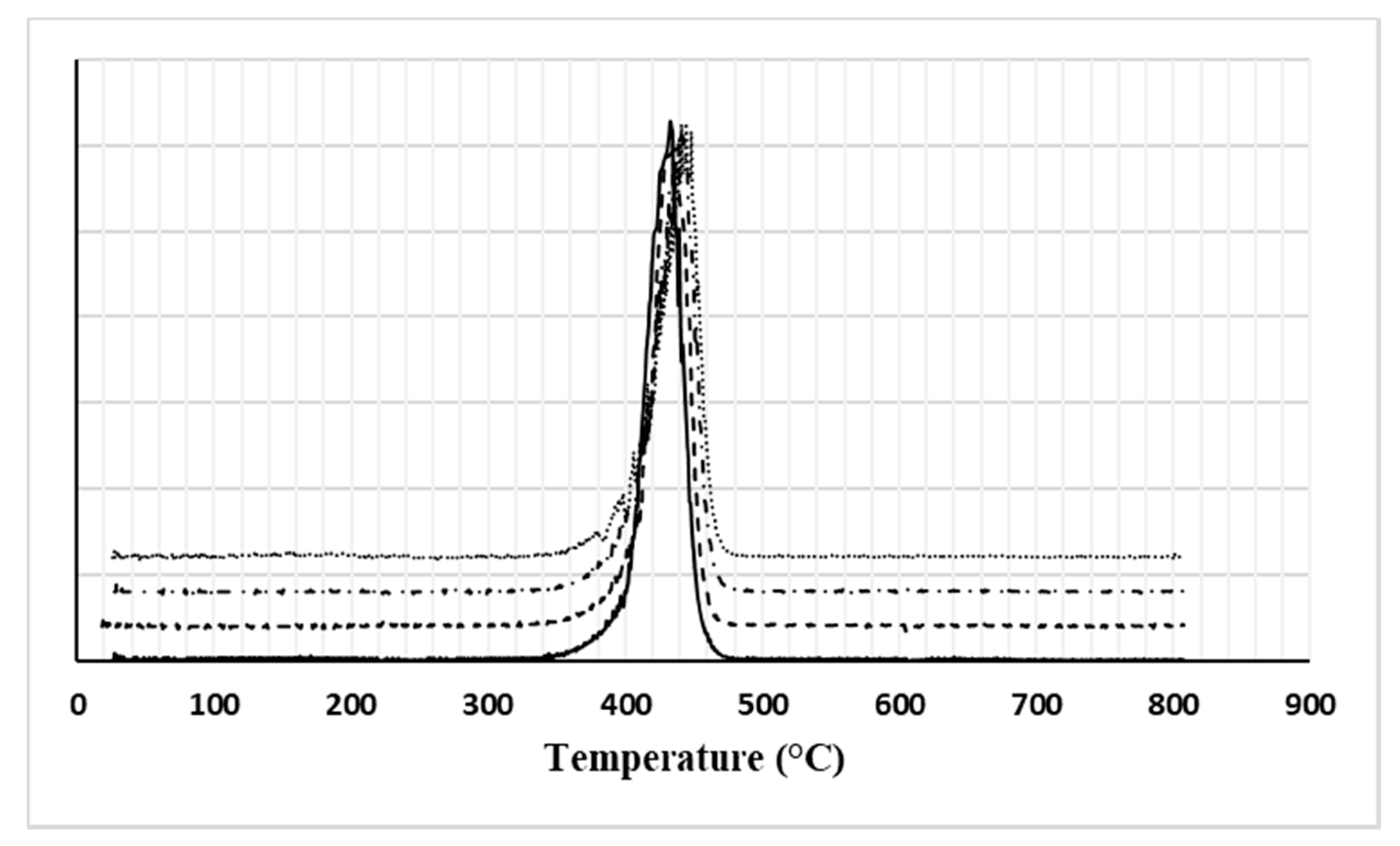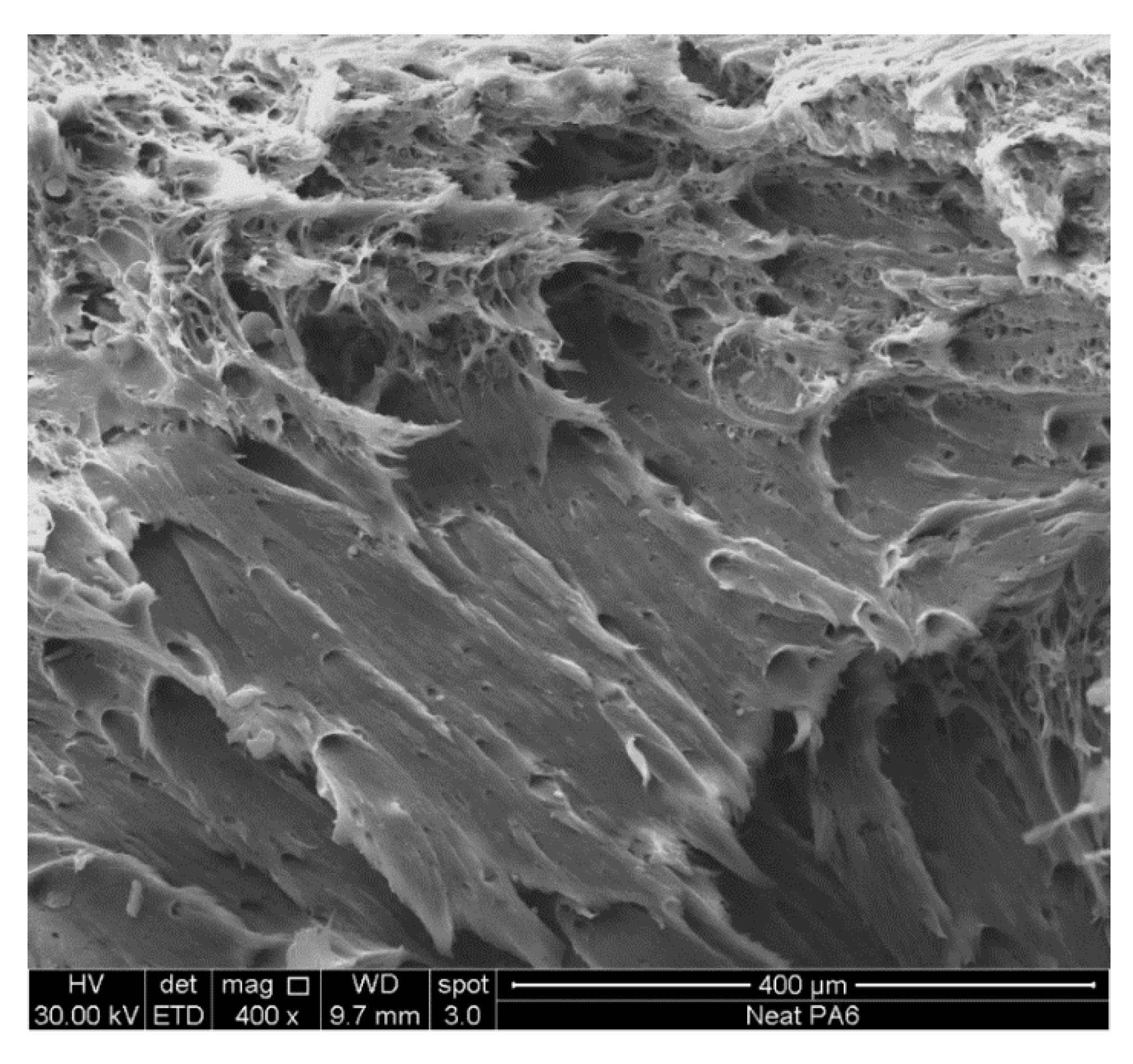Thermal and Quasi-Static Mechanical Characterization of Polyamide 6-Graphene Nanoplatelets Composites
Abstract
:1. Introduction
2. Materials and Methods
2.1. Materials
2.2. Compound Preparation
2.3. Characterization Techniques
3. Results and Discussion
3.1. Thermal Properties
- (a)
- The temperature corresponding to the 5% weight reduction, reasonably associated with the thermal stability of the materials, is improved by increasing the filler content. This effect is usually attributed to the consolidated ability of graphene to prevent the emission of volatiles and, thanks to its lamellar structure, to hinder the permeation of oxygen (barrier effect) [20].
- (b)
- The inclusion of GNPs also promotes a slowing down of the degradation kinetics as the filler content increases. This effect, attributable to the organization of graphene flakes in rigid mesostructures hindering the progress of degradation phenomena, is manifested by the slight shift of the peak temperature (Td) towards higher values, especially for GNP contents up to 3% by weight as well as by the progressive reduction of the peak height (PH) compared to the pure reference PA6 matrix.
- (c)
- The amount of the residue (ashes) at 800 °C increases from approximately 2%, for the neat matrix, up to about 6%, measured for the compound with the highest GNPs content. This trend, although it does not faithfully reflect the added filler content, reasonably shows a monotonically increasing trend. Among other things, these data also depend on the degradation mechanisms of the GNP used, governed, in turn, by the possible presence of residues of surfactants used during the industrial synthesis of the product to favour its exfoliation [21], degradation of any labile functional groups [22], and/or impurities usually not detailed in the technical data sheet of the carbonaceous filler. In this regard, it is worth pointing out that the technical data sheet of the G2Nan filler reports a residue at 800 °C, derived from a thermogravimetric analysis in nitrogen, which amounts to about 3.8% by weight but does not provide any information regarding the nature of the same.
3.2. Quasi-Static Mechanical Behaviour
3.3. Morphological Analysis
4. Conclusions
- The inclusion of GNP hinders the crystallization of the polyamide matrix, which shows an evident reduction in the degree of crystallinity, especially for contents up to 3% by weight of filler. Further additions of GNP seem to have no major repercussions on this parameter, which, however, does not reverse this trend.
- Graphene nanoplatelet compounds, in addition to confirming the improvement in thermal stability widely consolidated in the literature, slightly increase the maximum temperature of the derived signal and progressively reduce its height without changing its shape.
- Tensile and bending stiffness of compounds increase with the GNP content, but the strength parameter, for both types of loading, shows a non-monotonous trend. Specifically, a non-monotonous trend was detected for this parameter essentially dominated by the inevitable aggregation phenomena of graphene sheets for contents above a threshold value usually dependent on a multitude of factors such as aspect ratio of the filler, matrix viscosity, interfacial issues, and so on. This behaviour, also favoured by the foreseeable increase in viscosity of the host molten matrix, was supported by SEM micrographs of sections of specimens broken under tensile tests.
Author Contributions
Funding
Conflicts of Interest
References
- Serrano-Garcia, W.; Jayathilaka, W.A.D.M.; Chinnappan, A.; Tran, T.Q.; Baskar, C.; Thomas, S.W.; Ramakrishna, S. Nanocomposites for electronic applications that can be embedded for textiles and wearables. Sci. China Ser. E Technol. Sci. 2019, 62, 895–902. [Google Scholar] [CrossRef]
- Tran, T.Q.; Lee, J.K.Y.; Chinnappan, A.; Jayathilaka, W.; Ji, D.; Kumar, V.V.; Ramakrishna, S. Strong, lightweight, and highly conductive CNT/Au/Cu wires from sputtering and electroplating methods. J. Mater. Sci. Technol. 2020, 40, 99–106. [Google Scholar] [CrossRef]
- Kim, H.; Miura, Y.; Macosko, C.W. Graphene/Polyurethane Nanocomposites for Improved Gas Barrier and Electrical Conductivity. Chem. Mater. 2010, 22, 3441–3450. [Google Scholar] [CrossRef]
- Yang, G.-H.; Bao, D.-D.; Liu, H.; Zhang, D.-Q.; Wang, N.; Li, H.-T. Functionalization of Graphene and Applications of the Derivatives. J. Inorg. Organomet. Polym. Mater. 2017, 27, 1129–1141. [Google Scholar] [CrossRef]
- Yu, W.; Sisi, L.; Haiyan, Y.; Jie, L. Progress in the functional modification of graphene/graphene oxide: A review. RSC Adv. 2020, 10, 15328–15345. [Google Scholar] [CrossRef]
- Dehghanzad, B.; Aghjeh, M.K.R.; Rafeie, O.; Tavakoli, A.; Oskooie, A.J. Synthesis and characterization of graphene and functionalized graphene via chemical and thermal treatment methods. RSC Adv. 2016, 6, 3578–3585. [Google Scholar] [CrossRef]
- Shang, Y.; Li, T.; Li, H.; Dang, A.; Zhang, L.; Yin, Y.; Xiong, C.; Zhao, T. Preparation and characterization of graphene derived from low-temperature and pressure promoted thermal reduction. Compos. Part B Eng. 2016, 99, 106–111. [Google Scholar] [CrossRef]
- Wang, S.; Yi, M.; Shen, Z. The effect of surfactants and their concentration on the liquid exfoliation of graphene. RSC Adv. 2016, 6, 56705–56710. [Google Scholar] [CrossRef] [Green Version]
- Peng, Y.; Gardner, D.J.; Han, Y. Characterization of mechanical and morphological properties of cellulose reinforced polyamide 6 composites. Cellulose 2015, 22, 3199–3215. [Google Scholar] [CrossRef]
- Chen, K.; Jia, M.; Sun, H.; Xue, P. Thermoplastic reaction injection pultrusion for continuous glass fibre-reinforced polyamide-6 composites. Materials 2019, 12, 463. [Google Scholar] [CrossRef] [Green Version]
- Bragaglia, M.; Lamastra, F.R.; Russo, P.; Vitiello, L.; Rinaldi, M.; Fabbrocino, F.; Nanni, F. A comparison of thermally conductive polyamide 6-boron nitride composites produced via additive layer manufacturing and compression molfing. Polym. Comp. 2021. [Google Scholar] [CrossRef]
- Vasiljević, J.; Demšar, A.; Leskovšek, M.; Simončič, B.; Čelan Korošin, N.; Jerman, I.; Šobak, M.; Žitko, G.; Van De Velde, N.; Čolović, M. Characterization of Polyamide 6/Multilayer Graphene Nanoplatelet Composite Textile Filaments Obtained Via In Situ Polymerization and Melt Spinning. Polymers 2020, 12, 1787. [Google Scholar] [CrossRef] [PubMed]
- Lee, K.P.M.; Czajka, M.; Shanks, R.; Daver, F. Low-defect graphene-polyamide-6 composites and modelling the filler-matrix interface. J. App. Polym. Sci. 2020, 137, 48630. [Google Scholar] [CrossRef]
- O’Neill, A.; Bakirtzis, D.; Dixon, D. Polyamide 6/graphene composites: The effect of in situ polymerization on the structure and properties of graphene oxide and reduced graphene oxide. Eur. Polym. J. 2014, 59, 353–362. [Google Scholar] [CrossRef]
- Fu, X.; Yao, C.; Yang, G. Recent advances in graphene/polyamide 6 composites: A review. RSC Adv. 2015, 5, 61688–61702. [Google Scholar] [CrossRef]
- Mayoral, B.; Harkin-Jones, E.; Khanam, P.N.; Al-Maadeed, M.A.; Ouederni, M.; Hamilton, A.R.; Sun, D. Melt processing and characterization of polyamide 6/graphene nanoplatelet composites. RSC Adv. 2015, 5, 52395–52409. [Google Scholar] [CrossRef] [Green Version]
- Gomez, J.; Villaro, E.; Karagiannidis, P.G.; Elmarakbi, A. Effects of chemical structure and morphology of graphene-related materials (GRMs) on melt processing and properties of GRM/polyamide-6 nanocomposites. Results Mater. 2020, 7, 100105. [Google Scholar] [CrossRef]
- Lee, K.; Brandt, M.; Shanks, R.; Daver, F. Rheology and 3D Printability of Percolated Graphene–Polyamide-6 Composites. Polymers 2020, 12, 2014. [Google Scholar] [CrossRef]
- Wunderlich, B. Macromolecular Physics. In The Growth of Crystals, 1st ed.; Academic Press: New York, NY, USA, 1976; Volume 3, pp. 115–347. [Google Scholar]
- Zhang, Q.; Wang, Y.C.; Bailey, C.G.; Yuen, R.K.; Parkin, J.; Yang, W.; Vallés, C. Quantifying effects of graphene nanoplatelets on slowing down combustion of epoxy composites. Compos. Part B Eng. 2018, 146, 76–87. [Google Scholar] [CrossRef]
- Parviz, D.; Das, S.; Ahmed, H.S.T.; Irin, F.; Bhattacharia, S.; Green, M.J. Dispersions of Non-Covalently Functionalized Graphene with Minimal Stabilizer. ACS Nano 2012, 6, 8857–8867. [Google Scholar] [CrossRef]
- Loryuenyong, V.; Totepvimarn, K.; Eimburanapravat, P.; Boonchompoo, W.; Buasri, A. Preparation and Characterization of Reduced Graphene Oxide Sheets via Water-Based Exfoliation and Reduction Methods. Adv. Mater. Sci. Eng. 2013, 2013, 1–5. [Google Scholar] [CrossRef] [Green Version]
- Chen, Y.-C.; Lin, H.-C.; Lee, Y.-D. The Effects of Filler Content and Size on the Properties of PTFE/SiO2Composites. J. Polym. Res. 2003, 10, 247–258. [Google Scholar] [CrossRef]
- Scaffaro, R.; Botta, L.; Mistretta, M.C.; La Mantia, F.P. Processing-morphology-property relationships of polyamide 6/polyethylene blend-clay nanocomposites. eXPRESS Polym. Lett. 2013, 7, 873–884. [Google Scholar] [CrossRef] [Green Version]
- Kusar, R. Trends in graphene reinforced polyamide nanocomposite for functional application: A review. Polym. Plast. Technol. Mater. 2019, 58, 917–933. [Google Scholar] [CrossRef]






| Sample | Tm (°C) | ΔHm (J/g) | Xc (%) |
|---|---|---|---|
| PA6 | 217 ± 1 | 57.2 ± 2.3 | 24.9 |
| PA6 + 1 wt% GNPs | 217 ± 3 | 53.7 ± 1.5 | 23.3 |
| PA6 + 3 wt% GNPs | 218 ± 2 | 48.5 ± 3.0 | 21.1 |
| PA6 + 5 wt% GNPs | 218 ± 1 | 47.1 ± 1.1 | 20.5 |
| Sample | T5% (°C) | Td (°C) | PH (wt%/min) | Residue at 800 °C (%) |
|---|---|---|---|---|
| PA6 | 386.0 ± 1.5 | 434.0 ± 0.8 | 30.7 ± 1.7 | 1.7 |
| PA6 + 1% GNP | 389.1 ± 0.8 | 438.9 ± 0.5 | 28.3 ± 0.8 | 3.5 |
| PA6 + 3% GNP | 390.2 ± 0.9 | 440.7 ± 0.4 | 26.6 ± 0.8 | 4.1 |
| PA6 + 5% GNP | 395.3 ± 0.5 | 441.1 ± 0.6 | 25.3 ± 0.6 | 5.8 |
| Sample | Young’s Modulus (MPa) | Tensile Strength (MPa) | Strain at Break (%) |
|---|---|---|---|
| PA6 | 1041 ± 141 | 44.18 ± 0.96 | 29.87 ± 1.47 |
| PA6 + 1% GNP | 1122 ± 100 | 45.37 ± 1.57 | 23.62 ± 5.22 |
| PA6 + 3% GNP | 1167 ± 113 | 48.11 ± 0.69 | 8.64 ± 1.33 |
| PA6 + 5% GNP | 1179 ± 44 | 31.06 ± 1.73 | 7.14 ± 1.21 |
| Sample | Modulus (MPa) | Flexural Strength (MPa) |
|---|---|---|
| PA6 | 1996 ± 154 | 45.91 ± 0.53 |
| PA6 + 1% GNP | 2405 ± 94 | 46.32 ± 2.84 |
| PA6 + 3% GNP | 3482 ± 101 | 61.04 ± 2.05 |
| PA6 + 5% GNP | 3303 ± 198 | 54.15 ± 2.06 |
Publisher’s Note: MDPI stays neutral with regard to jurisdictional claims in published maps and institutional affiliations. |
© 2021 by the authors. Licensee MDPI, Basel, Switzerland. This article is an open access article distributed under the terms and conditions of the Creative Commons Attribution (CC BY) license (https://creativecommons.org/licenses/by/4.0/).
Share and Cite
Russo, P.; Cimino, F.; Tufano, A.; Fabbrocino, F. Thermal and Quasi-Static Mechanical Characterization of Polyamide 6-Graphene Nanoplatelets Composites. Nanomaterials 2021, 11, 1454. https://doi.org/10.3390/nano11061454
Russo P, Cimino F, Tufano A, Fabbrocino F. Thermal and Quasi-Static Mechanical Characterization of Polyamide 6-Graphene Nanoplatelets Composites. Nanomaterials. 2021; 11(6):1454. https://doi.org/10.3390/nano11061454
Chicago/Turabian StyleRusso, Pietro, Francesca Cimino, Antonio Tufano, and Francesco Fabbrocino. 2021. "Thermal and Quasi-Static Mechanical Characterization of Polyamide 6-Graphene Nanoplatelets Composites" Nanomaterials 11, no. 6: 1454. https://doi.org/10.3390/nano11061454
APA StyleRusso, P., Cimino, F., Tufano, A., & Fabbrocino, F. (2021). Thermal and Quasi-Static Mechanical Characterization of Polyamide 6-Graphene Nanoplatelets Composites. Nanomaterials, 11(6), 1454. https://doi.org/10.3390/nano11061454








